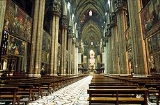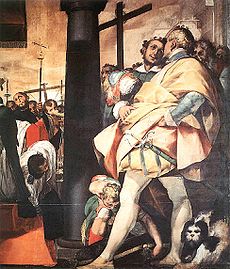
Quadroni of St. Charles
Encyclopedia
The Quadroni of St. Charles Borromeo are two cycles of paintings depicting the life and miracle
s of the first Saint
of the Counter Reformation. These very large paintings (approx. 5 x 6 m) are displayed during the month of November in the Duomo of Milan
in honor of St. Charles' name day
on November 4. They were exhibited continuously from November 4, 1999 - November 4, 2000 in honor of the Catholic
Jubilee
celebrations.
 The first cycle, begun in 1602, 26 years after his death, is the larger of the two- I fatti della vita del beato Carlo (The Facts of the Life of Blessed Charles). It consists of 28 paintings depicting his life, concentrating upon his tenure as Archbishop of Milan. Work on this cycle continued into the late 18th century. The first twenty large canvases were painted by Il Cerano (4 paintings), Giovanni Mauro della Rovere (Il Fiammenghino) (3), Il Duchino (7), Procaccini
The first cycle, begun in 1602, 26 years after his death, is the larger of the two- I fatti della vita del beato Carlo (The Facts of the Life of Blessed Charles). It consists of 28 paintings depicting his life, concentrating upon his tenure as Archbishop of Milan. Work on this cycle continued into the late 18th century. The first twenty large canvases were painted by Il Cerano (4 paintings), Giovanni Mauro della Rovere (Il Fiammenghino) (3), Il Duchino (7), Procaccini
(1), Carlo Buzzi (2), Domenico Pellegrini
(1), and Morazzone
. The paintings are all tempera
on canvas.
 The second cycle, I miracoli di San Carlo (The Miracles of St. Charles) consists of 24 paintings of his miraculous works and healings. These paintings are smaller than the first set, measuring approximately 2.4 x 4.4 m. They were all painted between December, 1609 and November 1, 1610 when St. Charles was canonized. These paintings were displayed together with the Life cycle for the first time on November 4, 1610 in the Duomo of Milan. The paintings of his miracles could not be displayed until he had been declared a Saint.
The second cycle, I miracoli di San Carlo (The Miracles of St. Charles) consists of 24 paintings of his miraculous works and healings. These paintings are smaller than the first set, measuring approximately 2.4 x 4.4 m. They were all painted between December, 1609 and November 1, 1610 when St. Charles was canonized. These paintings were displayed together with the Life cycle for the first time on November 4, 1610 in the Duomo of Milan. The paintings of his miracles could not be displayed until he had been declared a Saint.
Miracle
A miracle often denotes an event attributed to divine intervention. Alternatively, it may be an event attributed to a miracle worker, saint, or religious leader. A miracle is sometimes thought of as a perceptible interruption of the laws of nature. Others suggest that a god may work with the laws...
s of the first Saint
Saint
A saint is a holy person. In various religions, saints are people who are believed to have exceptional holiness.In Christian usage, "saint" refers to any believer who is "in Christ", and in whom Christ dwells, whether in heaven or in earth...
of the Counter Reformation. These very large paintings (approx. 5 x 6 m) are displayed during the month of November in the Duomo of Milan
Duomo di Milano
Milan Cathedral is the cathedral church of Milan, Italy. Dedicated to Santa Maria Nascente , it is the seat of the Archbishop of Milan, currently Cardinal Angelo Scola....
in honor of St. Charles' name day
Name day
A name day is a tradition in many countries in Europe and Latin America that consists of celebrating the day of the year associated with one's given name....
on November 4. They were exhibited continuously from November 4, 1999 - November 4, 2000 in honor of the Catholic
Catholic
The word catholic comes from the Greek phrase , meaning "on the whole," "according to the whole" or "in general", and is a combination of the Greek words meaning "about" and meaning "whole"...
Jubilee
Jubilee (Christian)
The concept of the Jubilee is a special year of remission of sins and universal pardon. In the Biblical Book of Leviticus, a Jubilee year is mentioned to occur every fifty years, in which slaves and prisoners would be freed, debts would be forgiven and the mercies of God would be particularly...
celebrations.

Giulio Cesare Procaccini
Giulio Cesare Procaccini was an Italian painter and sculptor of the early Baroque era in Milan.-Biography:Born in Bologna he was son of the Mannerist painter Ercole Procaccini the Elder and brother of Camillo Procaccini and Carlo Antonio Procaccini...
(1), Carlo Buzzi (2), Domenico Pellegrini
Domenico Pellegrini
Domenico Pellegrini may refer to:* Domenico Pellegrini Giampietro, fascist academic in Italy* Domenico Pellegrini , 17th century painter in Milan...
(1), and Morazzone
Pier Francesco Mazzucchelli
Pier Francesco Mazzucchelli was an Italian painter of the early Baroque era in Milan....
. The paintings are all tempera
Tempera
Tempera, also known as egg tempera, is a permanent fast-drying painting medium consisting of colored pigment mixed with a water-soluble binder medium . Tempera also refers to the paintings done in this medium. Tempera paintings are very long lasting, and examples from the 1st centuries AD still exist...
on canvas.


